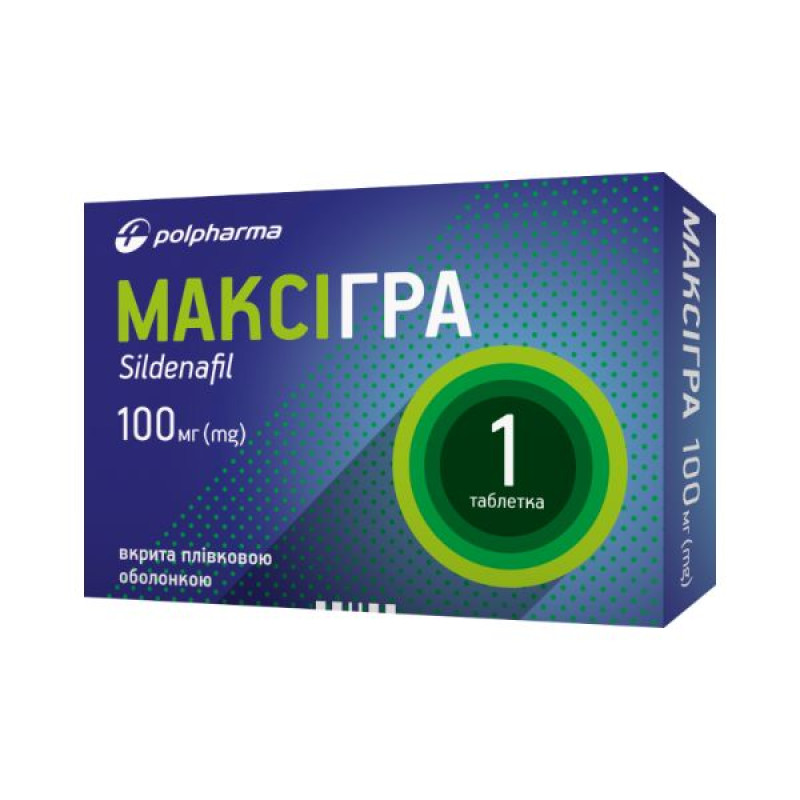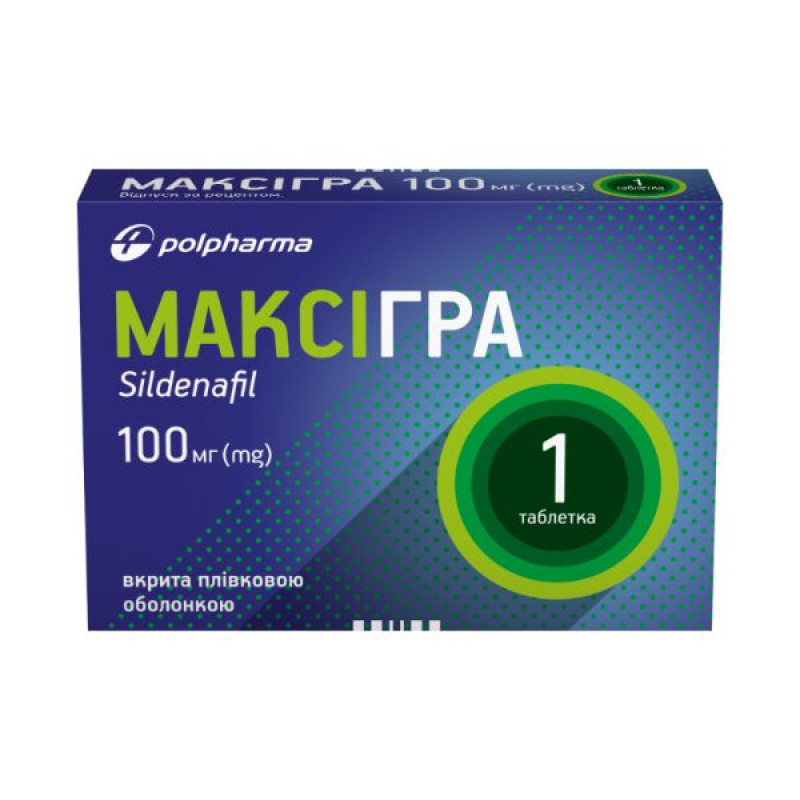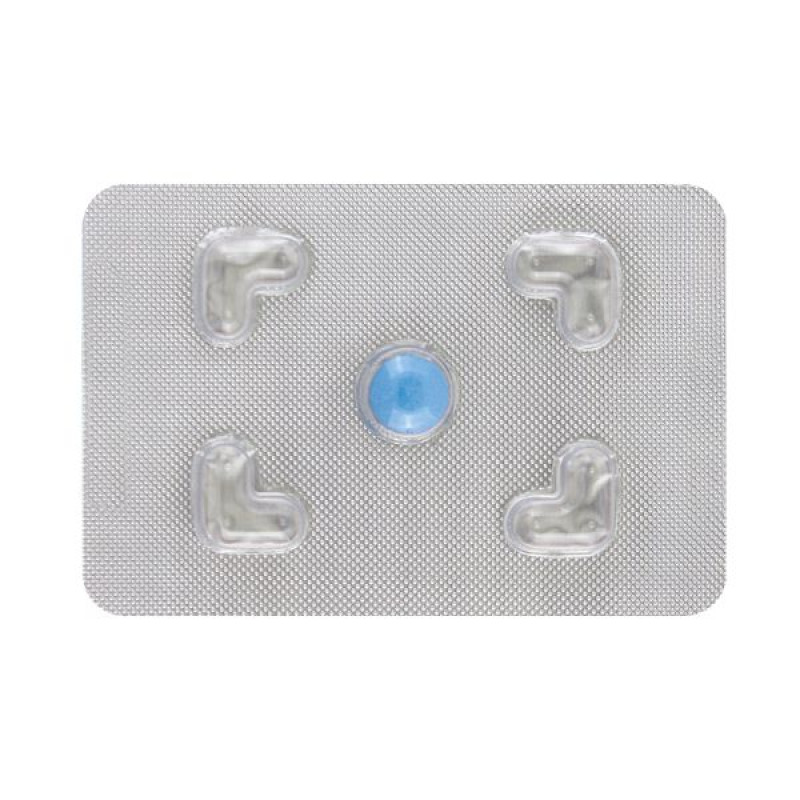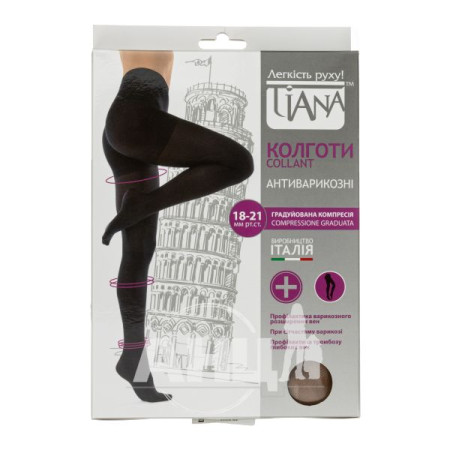Maxigra film-coated tablets 100 mg blister No. 1

Instructions for Maxigra film-coated tablets 100 mg blister No. 1
Composition
active ingredient: sildenafil;
1 tablet contains sildenafil citrate, equivalent to sildenafil 50 mg or 100 mg;
excipients: mannitol (E 421), crospovidone (type A), povidone K-30, corn starch, sodium lauryl sulfate, magnesium stearate, colloidal anhydrous silicon dioxide;
shell: hypromellose, magrogol 6000, titanium dioxide (E 171), talc, indigo carmine (E 132).
Dosage form
Film-coated tablets.
Main physicochemical properties: round, biconvex tablets, coated with a blue film coating.
Pharmacotherapeutic group
Drugs used for erectile dysfunction. Sildenafil. ATX code G04B E03.
Pharmacological properties
Pharmacodynamics: Sildenafil is an oral drug indicated for the treatment of erectile dysfunction. During sexual arousal, the drug restores impaired erectile function by increasing blood flow to the penis.
The physiological mechanism that causes an erection involves the release of nitric oxide (NO) in the corpora cavernosa during sexual arousal. The released nitric oxide activates the enzyme guanylate cyclase, which stimulates an increase in cyclic guanosine monophosphate (cGMP), which in turn causes relaxation of the smooth muscle of the corpora cavernosa, facilitating blood flow.
Sildenafil is a potent and selective inhibitor of cGMP-specific phosphodiesterase 5 (PDE5) in the corpus cavernosum, where PDE5 is responsible for the breakdown of cGMP. The effects of sildenafil on erection are peripheral in nature. Sildenafil does not cause a direct relaxant effect on isolated human corpus cavernosum, but potently enhances the relaxant effect of NO on this tissue. When the NO/cGMP metabolic pathway is activated, which occurs during sexual stimulation, sildenafil's inhibition of PDE5 leads to an increase in cGMP levels in the corpus cavernosum. Thus, sexual arousal is required for sildenafil to produce the desired pharmacological effect.
In vitro studies have shown the selectivity of sildenafil for PDE5, which is actively involved in the erection process. The effect of sildenafil on PDE5 is more potent than on other known phosphodiesterases. This effect is 10 times more potent than the effect on PDE6, which is involved in photoconversion processes in the retina. When using the maximum recommended doses, the selectivity of sildenafil for PDE5 is 80 times higher than its selectivity for PDE1, 700 times higher than for PDE2, PDE3, PDE4, PDE7, PDE8, PDE9, PDE10 and PDE11. In particular, the selectivity of sildenafil for PDE5 is 4000 times higher than its selectivity for PDE3 - a cGMP-specific isoform of phosphodiesterase involved in the regulation of cardiac contractility.
Two separate clinical trials were conducted to assess the time it takes for sildenafil to produce an erection in response to sexual stimulation. In clinical trials in patients taking sildenafil in the fasted state, the median time to onset of erection in patients achieving a 60% erection (sufficient for sexual intercourse) using phallopleythysmography (RigiScan) was 25 minutes (range 12-37 minutes). In a separate study using RigiScan, sildenafil was still able to induce an erection 4-5 hours after administration.
Sildenafil causes a mild and transient decrease in blood pressure, which in most cases is not clinically evident. The mean maximum decrease in supine systolic blood pressure after oral administration of sildenafil at a dose of 100 mg was 8.4 mm Hg. The corresponding change in supine diastolic blood pressure was 5.5 mm Hg. These decreases in blood pressure are well consistent with the vasodilatory effect of sildenafil, possibly due to an increase in cGMP levels in vascular smooth muscle. Single oral doses of sildenafil up to 100 mg in healthy volunteers did not cause any clinically significant changes in the electrocardiogram.
In a study of the hemodynamic effects of a single oral dose of sildenafil 100 mg in 14 patients with severe coronary artery disease (with stenosis of at least one coronary artery >70%), mean resting systolic and diastolic blood pressure decreased by 7% and 6%, respectively, from baseline. Mean pulmonary systolic pressure decreased by 9%. Sildenafil did not alter cardiac output or reduce blood flow in stenosed coronary arteries.
Mild and transient color vision impairment (blue/green) was observed in some patients in the Farnsworth-Munsell 100-shade test 1 hour after sildenafil 100 mg. These effects completely disappeared 2 hours after administration. The possible mechanism of this change in color vision is related to inhibition of PDE6, which is involved in the photoconversion cascade in the retina. Sildenafil does not affect visual acuity or contrast sensitivity. In small placebo-controlled clinical studies in patients with documented macular degeneration (n=9), sildenafil (single dose, 100 mg) did not cause significant changes in the results of visual tests (visual acuity, Amsler grid, simulated traffic light color recognition, Humphrey perimeter, and photostress).
A single oral dose of sildenafil 100 mg in healthy volunteers had no effect on sperm motility or morphology.
Additional clinical trial data.
In clinical trials, sildenafil was used in more than 8,000 patients aged 19 to 87 years. The following patient groups were represented: elderly patients (19.9%), patients with arterial hypertension (30.9%), patients with diabetes mellitus (20.3%), coronary heart disease (5.8%), hyperlipidemia (19.8%), spinal cord injury (0.6%), depression (5.2%), transurethral resection of the prostate (3.7%), radical prostatectomy (3.3%). Patient groups that were not adequately represented or included in clinical trials: patients after pelvic surgery, patients after radiation therapy, patients with severe renal or hepatic insufficiency, and patients with certain cardiovascular diseases.
In fixed-dose studies, the number of patients reporting improvement in erectile function was 62% (25 mg), 74% (50 mg), and 82% (100 mg) compared with 25% in the placebo group. In controlled clinical trials, the rate of sildenafil discontinuation was low and similar to that in the placebo group.
For all these studies, the number of patients who reported improvement with sildenafil was as follows: patients with psychogenic erectile dysfunction (84%), patients with mixed erectile dysfunction (77%), patients with organic erectile dysfunction (68%), elderly patients (67%), patients with diabetes mellitus (59%), patients with coronary heart disease (69%), patients with hypertension (68%), patients with transurethral resection of the prostate (61%), patients with radical prostatectomy (43%), patients with spinal cord injury (83%), patients with depression (75%). The safety and efficacy of sildenafil have been confirmed by data from long-term studies.
Pharmacokinetics.
Absorption. Sildenafil is rapidly absorbed. Peak plasma concentrations are reached within 30-120 minutes (median 60 minutes) after oral administration in the fasted state. The mean absolute oral bioavailability is 41% (range 25-63%). Over the recommended dose range (25-100 mg), the AUC and Cmax of sildenafil increase proportionally with dose after oral administration.
When sildenafil is taken with food, the extent of absorption is reduced with a mean prolongation of Tmax to 60 minutes and a mean decrease in Cmax by 29%.
Distribution. The mean steady-state volume of distribution (Vd) is 105 liters, indicating distribution of the drug into body tissues. After a single oral dose of 100 mg sildenafil, the mean maximum total plasma concentration of sildenafil is approximately 440 ng/mL (the coefficient of variation is 40%). Since the binding of sildenafil and its major N-desmethyl metabolite to plasma proteins reaches 96%, the mean maximum plasma concentration of free sildenafil reaches 18 ng/mL (38 nmol). The extent of binding to plasma proteins is independent of the total concentrations of sildenafil.
In healthy volunteers who used sildenafil once at a dose of 100 mg, less than 0.0002% (average 188 ng) of the administered dose was detected in the ejaculate after 90 minutes.
Metabolism. Sildenafil is metabolized primarily by the hepatic microsomal isoenzymes CYP3A4 (major pathway) and CYP2C9 (minor pathway). The major circulating metabolite is formed by N-demethylation of sildenafil. The selectivity of the metabolite for PDE5 is comparable to that of sildenafil, and the activity of the metabolite for PDE5 is approximately 50% of that of the parent compound. Plasma concentrations of this metabolite are approximately 40% of those of sildenafil in plasma. The N-demethylated metabolite undergoes further metabolism and has a half-life of approximately 4 hours.
Elderly patients: In healthy elderly volunteers (aged 65 years and older), a decrease in sildenafil clearance was observed, which resulted in an increase in plasma concentrations of sildenafil and its active N-demethylated metabolite by approximately 90% compared with the corresponding concentrations in healthy younger volunteers (18-45 years). Due to age-related differences in plasma protein binding, the corresponding increase in plasma concentrations of free sildenafil was approximately 40%.
Renal impairment. In volunteers with mild to moderate renal impairment (creatinine clearance 30 to 80 ml/min), sildenafil pharmacokinetics were unchanged after a single oral dose of 50 mg. The mean AUC and Cmax of the N-desmethyl metabolite were increased by 126% and 73%, respectively, compared with those in age-matched volunteers without renal impairment. However, due to high interindividual variability, these differences were not statistically significant. In volunteers with severe renal impairment (creatinine clearance below 30 ml/min), sildenafil clearance was reduced, resulting in mean increases in AUC and Cmax of 100% and 88%, respectively, compared with age-matched volunteers without renal impairment. In addition, the AUC and Cmax values of the N-demethylated metabolite were significantly increased by 79% and 200%, respectively.
Hepatic impairment: In volunteers with mild to moderate liver cirrhosis (Child-Pugh class A and B), sildenafil clearance was reduced, resulting in increased AUC (84%) and Cmax (47%) compared to age-matched volunteers without hepatic impairment. The pharmacokinetics of sildenafil in patients with severe hepatic impairment have not been studied.
Indication
Treatment of erectile dysfunction, defined as the inability to achieve and maintain a penile erection necessary for successful sexual intercourse.
For Maxigra to be effective, sexual arousal is required.
Contraindication
- Hypersensitivity to the active substance or any of the excipients of the drug.
- Concomitant use with nitric oxide donors (such as amyl nitrite) or nitrates in any form, as sildenafil is known to affect the nitric oxide/cyclic guanosine monophosphate (cGMP) metabolic pathways and potentiate the hypotensive effect of nitrates.
- Conditions in which sexual activity is not recommended (e.g. severe cardiovascular disorders such as unstable angina and severe heart failure).
- Loss of vision in one eye due to non-arteritic anterior ischemic optic neuropathy, regardless of whether this pathology is related to previous use of PDE5 inhibitors or not.
- Severe hepatic impairment, arterial hypotension (blood pressure below 90/50 mm Hg), recent stroke or myocardial infarction and known hereditary degenerative retinal diseases such as retinitis pigmentosa (a small number of such patients have genetic disorders of retinal phosphodiesterases), as the safety of sildenafil has not been studied in patients with such diseases.
Interaction with other medicinal products and other types of interactions
Effects of other drugs on sildenafil.
In vitro studies.
Sildenafil is metabolized primarily by cytochrome P450 (CYP) isoform 3A4 (major pathway) and isoform 2C9 (minor pathway). Therefore, inhibitors of these isoenzymes may reduce sildenafil clearance.
In vivo studies.
Population pharmacokinetic analysis of clinical trial data has shown a decrease in sildenafil clearance when co-administered with CYP3A4 inhibitors (such as ketoconazole, erythromycin, cimetidine). Although no increase in adverse events was observed when sildenafil was co-administered with CYP3A4 inhibitors, the recommended starting dose of sildenafil is 25 mg.
Co-administration of the HIV protease inhibitor ritonavir, a very potent P450 inhibitor, at steady state (500 mg once daily) with sildenafil (single dose of 100 mg) resulted in a 300% (4-fold) increase in sildenafil Cmax and a 1000% (11-fold) increase in sildenafil plasma AUC. After 24 hours, plasma sildenafil levels were still approximately 200 ng/ml compared to approximately 5 ng/ml with sildenafil alone, consistent with the significant effect of ritonavir on a wide range of P450 substrates. Sildenafil does not affect the pharmacokinetics of ritonavir. Based on these pharmacokinetic data, co-administration of sildenafil and ritonavir is not recommended; in any case, the maximum dose of sildenafil should not exceed 25 mg within 48 hours.
When sildenafil (100 mg once daily) was administered with erythromycin, a specific CYP3A4 inhibitor, at steady state (500 mg twice daily for 5 days), a 182% increase in systemic exposure (AUC) to sildenafil was observed. In healthy male volunteers, there was no effect of azithromycin (500 mg daily for 3 days) on the AUC, Cmax, Tmax, elimination rate constant, and subsequent half-life of sildenafil or its major circulating metabolite. Cimetidine (a cytochrome P450 inhibitor and non-specific CYP3A4 inhibitor) at a dose of 800 mg when co-administered with sildenafil at a dose of 50 mg in healthy volunteers resulted in a 56% increase in plasma concentrations of sildenafil.
Grapefruit juice is a weak inhibitor of CYP3A4 in the intestinal wall and may cause a modest increase in plasma levels of sildenafil.
Single administration of antacids (magnesium hydroxide/aluminum hydroxide) does not affect the bioavailability of sildenafil.
Although specific drug interaction studies have not been conducted, population pharmacokinetic analysis suggests that sildenafil pharmacokinetics were not altered by concomitant use of drugs belonging to the CYP2C9 inhibitor group (tolbutamide, warfarin, phenytoin), CYP2D6 inhibitor group (such as selective serotonin reuptake inhibitors, tricyclic antidepressants), thiazide and thiazide-like diuretics, loop and potassium-sparing diuretics, angiotensin-converting enzyme inhibitors, calcium antagonists, beta-adrenoceptor antagonists, or inducers of CYP450 metabolism (such as rifampicin, barbiturates).
Nicorandil is a hybrid of a calcium channel activator and a nitrate. The nitrate component makes it possible for it to have a serious interaction with sildenafil.
Effects of sildenafil on other drugs.
In vitro studies.
Sildenafil is a weak inhibitor of cytochrome P450 isoforms 1A2, 2C9, 2C19, 2D6, 2E1 and 3A4 (IC50 > 150 μmol). Since peak plasma concentrations of sildenafil are approximately 1 μmol, the effect of Maxigra on the clearance of substrates of these isoenzymes is unlikely.
There are no data on the interaction of sildenafil and non-specific phosphodiesterase inhibitors such as theophylline and dipyridamole.
In vivo studies.
Since sildenafil is known to have an effect on nitric oxide/cyclic guanosine monophosphate (cGMP) metabolism, it has been found that this drug potentiates the hypotensive effect of nitrates, therefore its simultaneous use with nitric oxide donors or with nitrates in any form is contraindicated.
Concomitant use of sildenafil and alpha-blockers may lead to symptomatic hypotension in some susceptible patients. This reaction most often occurred within 4 hours of sildenafil administration. In 3 specific drug interaction studies, the alpha-blocker doxazosin (4 mg and 8 mg) and sildenafil (25 mg, 50 mg and 100 mg) were administered concomitantly to patients with benign prostatic hyperplasia who were stabilized on doxazosin. In these populations, mean additional reductions in supine blood pressure of 7/7 mmHg, 9/5 mmHg and 8/4 mmHg and mean reductions in standing blood pressure of 6/6 mmHg, 11/4 mmHg and 4/5 mmHg, respectively, were observed. Symptomatic orthostatic hypotension has occasionally been reported in patients stabilized on doxazosin when sildenafil and doxazosin were co-administered. These reports included dizziness and fainting, but without syncope.
No significant interactions were observed with the concomitant use of sildenafil (50 mg) and tolbutamide (250 mg) or warfarin (40 mg), which are metabolized by CYP2C9.
Sildenafil (50 mg) did not prolong bleeding time induced by acetylsalicylic acid (150 mg).
Sildenafil (50 mg) did not potentiate the hypotensive effect of alcohol in healthy volunteers at mean maximum blood ethanol levels of 80 mg/dL.
In patients taking sildenafil, no differences in the side effect profile compared to placebo were observed when such classes of antihypertensive drugs as diuretics, beta-blockers, ACE inhibitors, angiotensin II antagonists, antihypertensive drugs (vasodilators and centrally acting), adrenergic neurone blockers, calcium channel blockers and alpha-adrenergic blockers were used concomitantly. In a dedicated interaction study, when sildenafil (100 mg) was co-administered with amlodipine in hypertensive patients, an additional reduction in supine systolic blood pressure of 8 mm Hg was observed. The corresponding reduction in diastolic blood pressure was 7 mm Hg. These additional reductions in blood pressure were comparable in magnitude to those observed with sildenafil alone in healthy volunteers.
Sildenafil at a dose of 100 mg did not affect the pharmacokinetics of the HIV protease inhibitors, saquinavir and ritonavir, which are CYP3A4 substrates.
Application features
Before starting therapy, the patient's medical history should be collected and a physical examination should be performed to diagnose erectile dysfunction and determine its possible causes.
Since sexual activity carries a certain cardiac risk, the physician should assess the patient's cardiovascular status before initiating any treatment for erectile dysfunction. Sildenafil has a vasodilating effect, manifested by a mild and transient decrease in blood pressure. Before prescribing sildenafil, the physician should carefully consider whether this effect may have an adverse effect on patients with certain underlying diseases, especially in combination with sexual activity. Patients with increased sensitivity to vasodilators include patients with obstruction of the outflow tract of the left ventricle (e.g., aortic stenosis, hypertrophic obstructive cardiomyopathy) or patients with the rare syndrome of multiple system atrophy, one of the manifestations of which is severe dysregulation of blood pressure by the autonomic nervous system.
Maxigra potentiates the hypotensive effect of nitrates.
In the post-marketing period, serious adverse reactions from the cardiovascular system, including myocardial infarction, unstable angina, sudden cardiac death, ventricular arrhythmia, cerebrovascular hemorrhage, transient ischemic attack, hypertension, and hypotension, have been reported in association with the use of Maxigra. Most, but not all, patients had risk factors for cardiovascular disease. Many of these adverse reactions occurred during or immediately after sexual intercourse, and only a few occurred shortly after the use of Maxigra without sexual activity. Therefore, it is not possible to determine whether the development of such adverse reactions is directly related to the risk factors or whether their development is due to other factors.
Erectile dysfunction drugs, including sildenafil, should be prescribed with caution in patients with anatomical deformities of the penis (such as angulation, cavernosal fibrosis, or Peyronie's disease) or in patients with conditions predisposing to priapism (such as sickle cell anemia, multiple myeloma, or leukemia).
The safety and efficacy of concomitant use of sildenafil with other treatments for erectile dysfunction have not been studied. Therefore, the use of such combinations is not recommended.
Visual disturbances and cases of non-arteritic anterior ischemic optic neuropathy have been reported with sildenafil and other PDE5 inhibitors. Patients should be advised that in the event of sudden visual impairment, Maxigra should be discontinued and a physician should be consulted immediately.
Concomitant use of sildenafil and ritonavir is not recommended.
Sildenafil should be used with caution in patients taking alpha-adrenergic blockers, as the combination may lead to symptomatic hypotension in some susceptible patients. Symptomatic hypotension usually occurs within 4 hours of sildenafil administration. To minimize the risk of orthostatic hypotension, sildenafil therapy should only be initiated in hemodynamically stable patients taking alpha-adrenergic blockers. The recommended starting dose for such patients is 25 mg sildenafil. In addition, patients should be informed of what to do if symptoms of orthostatic hypotension occur.
Studies in human platelets have shown that sildenafil potentiates the antiaggregatory effects of sodium nitroprusside in vitro. There is no information on the safety of sildenafil in patients with coagulation disorders or acute peptic ulcer. Therefore, the use of sildenafil in these patients should only be considered after careful consideration of the benefit-risk ratio.
Hearing loss. Physicians should advise patients to discontinue use of PDE5 inhibitors, including Maxigra, and seek immediate medical attention if they experience sudden decrease or loss of hearing. These events, which may also be accompanied by tinnitus and dizziness, have been reported in temporal association with the use of PDE5 inhibitors, including Maxigra. It is not possible to determine whether these events are directly related to the use of PDE5 inhibitors or to other factors.
Concomitant use with antihypertensive drugs. Maxigra has a systemic vasodilator effect and may further reduce blood pressure in patients taking antihypertensive drugs. In a separate drug interaction study, concomitant use of amlodipine (5 mg or 10 mg) and sildenafil (100 mg) orally resulted in an average additional reduction in systolic blood pressure of 8 mm Hg and diastolic blood pressure of 7 mm Hg.
Sexually transmitted diseases. Use of Maxigra does not protect against sexually transmitted diseases. Patients should be instructed on the need for precautions to protect against sexually transmitted diseases, including human immunodeficiency virus.
Use during pregnancy and breastfeeding
Maxigra is not intended for use by women.
Ability to influence reaction speed when driving vehicles or other mechanisms
No studies have been conducted on the effect of the drug on the ability to drive vehicles and work with other mechanisms.
Since dizziness and visual disturbances have been reported in clinical studies of sildenafil, patients should be aware of their individual reaction to Maxigra before driving or operating machinery.
Method of administration and doses
The drug is administered orally.
For Maxigra to be effective, sexual arousal is required.
Adults.
The recommended dose of Maxigra is 50 mg and is taken, if necessary, approximately one hour before sexual intercourse. Depending on the effectiveness and tolerability of the drug, the dose can be increased to 100 mg or reduced to 25 mg. The maximum recommended dose is 100 mg.
The maximum recommended frequency of use of the drug is 1 time per day. When using Maxigra with food, the effect of the drug may occur later than when used on an empty stomach.
Elderly patients.
There is no need for dose adjustment in elderly patients (≥ 65 years).
Patients with renal failure.
For patients with mild to moderate renal impairment (creatinine clearance 30 to 80 ml/min), the recommended dose is the same as that given above in the Adults section.
Since sildenafil clearance is reduced in patients with severe renal impairment (creatinine clearance below 30 ml/min), the recommended dose is 25 mg. Depending on the efficacy and tolerability of the drug, the dose may be increased to 50 mg and 100 mg.
Patients with liver failure.
Since sildenafil clearance is reduced in patients with hepatic impairment (e.g. cirrhosis), the recommended dose is 25 mg. Depending on the efficacy and tolerability of the drug, the dose may be increased to 50 mg and 100 mg.
Patients taking other medications (e.g. ketoconazole, erythromycin, cimetidine, ritonavir).
Detailed information is provided in the section “Interaction with other medicinal products and other types of interactions”.
The recommended starting dose for patients taking CYP3A4 inhibitors, with the exception of ritonavir, the use of which with sildenafil is not recommended, is 25 mg.
To minimize the risk of orthostatic hypotension, patients taking alpha-adrenergic blockers should be stabilized before starting sildenafil. The recommended starting dose of sildenafil is 25 mg.
Maxigra is not intended for use by women.
Children.
Maxigra is not indicated for use by persons under the age of 18.
Overdose
In clinical studies involving volunteers, when using a single dose of sildenafil up to 800 mg, adverse reactions were similar to those observed with sildenafil at lower doses, but were more frequent and more severe. The use of sildenafil at a dose of 200 mg did not lead to increased efficacy, but caused an increase in the number of cases of adverse reactions (headache, flushing, dizziness, dyspepsia, nasal congestion, visual disturbances).
In case of overdose, usual supportive measures should be employed as necessary. Acceleration of sildenafil clearance during hemodialysis is unlikely due to the high degree of binding of the drug to plasma proteins and the lack of elimination of sildenafil in the urine.
Adverse reactions
All clinically significant adverse reactions observed in clinical trials at an incidence greater than placebo are listed below by system organ class and frequency: very common (≥ 1/10), common (≥ 100 to < 1/10), uncommon (≥ 1,000 to < 1/100) and rare (≥ 10,000 to < 1/1,000). In addition, the frequency of clinically significant adverse reactions reported during post-marketing experience is not known.
Within each frequency grouping, adverse reactions are presented in order of decreasing seriousness.
Infectious and invasive diseases.
Uncommon: rhinitis.
Immune system disorders.
Uncommon: hypersensitivity.
Nervous system disorders.
Very common: headache.
Common: dizziness.
Uncommon: drowsiness, hypoesthesia.
Rare: stroke, transient ischemic attack, seizures*, recurrent seizures*, syncope.
Disorders of the organs of vision.
Common: color perception disorders**, visual disturbances, blurred vision.
Rare: non-arteritic anterior ischemic optic neuropathy*, retinal vascular occlusion*, retinal haemorrhage, arteriosclerotic retinopathy, retinal disorders, glaucoma, visual field defects, diplopia, visual acuity reduced, myopia, asthenopia, floating vitreous opacities, iris disorders, mydriasis, halos, eye oedema, eye swelling, eye disorders, conjunctival hyperaemia, eye irritation, abnormal sensation in eyes, eyelid oedema, sclera discolouration.
Disorders of the hearing and vestibular system.
Uncommon: dizziness, tinnitus.
Rare: deafness.
Heart disorders.
Uncommon: tachycardia, palpitations.
Rare: sudden cardiac death*, myocardial infarction, ventricular arrhythmia*, atrial fibrillation, unstable angina.
Vascular disorders.
Common: flushing, hot flushes.
Uncommon: hypertension, hypotension.
Disorders of the respiratory system, chest organs and mediastinum.
Common: nasal congestion.
Uncommon: epistaxis, sinus congestion.
Rare: feeling of tightness in the throat, swelling of the nasal mucosa, dry nose.
Gastrointestinal disorders.
Common: nausea, dyspepsia.
Uncommon: gastroesophageal reflux disease, vomiting, upper abdominal pain, dry mouth.
Rare: oral hypoesthesia.
Skin and subcutaneous tissue disorders.
Uncommon: rash.
Rare: Stevens-Johnson syndrome*, toxic epidermal necrolysis*.
Musculoskeletal and connective tissue disorders.
Uncommon: myalgia, pain in extremity.
Disorders of the urinary system.
Uncommon: hematuria.
Disorders of the reproductive system and mammary glands.
Rare: penile bleeding, priapism*, hematospermia, prolonged erection.
General disorders.
Uncommon: chest pain, fatigue, feeling hot.
Rare: irritation.
Examination.
Uncommon: increased heart rate.
*Reported only during post-marketing surveillance.
** Color perception disorders: chloropsia, chromatopsia, cyanopsia, erythropsia, xanthopsia.
*** Lacrimation disorders: dry eyes, lacrimation disorders and lacrimation increased.
The following events were observed in < 2% of patients in controlled clinical trials; causality has not been established. Reports included events that had a probable relationship to drug use.
General: Facial edema, photosensitivity reactions, shock, asthenia, pain, sudden fall, abdominal pain, sudden injury.
Cardiovascular system: angina pectoris, AV block, migraine, postural hypotension, myocardial ischemia, cerebral thrombosis, sudden cardiac arrest, ECG abnormalities, cardiomyopathy.
Gastrointestinal disorders: glossitis, colitis, dysphagia, gastritis, gastroenteritis, esophagitis, stomatitis, liver function test abnormalities, rectal bleeding, gingivitis.
From the blood and lymphatic system: anemia, leukopenia.
Metabolism and nutrition disorders: thirst, edema, gout, unstable diabetes, hyperglycemia, peripheral edema, hyperuricemia, hypoglycemia, hypernatremia.
Musculoskeletal disorders: arthritis, arthrosis, tendon rupture, tenosynovitis, bone pain, myasthenia gravis, synovitis.
Nervous system disorders: ataxia, neuralgia, neuropathy, paresthesia, tremor, vertigo, depression, insomnia, abnormal dreams, decreased reflexes.
Respiratory system disorders: asthma, dyspnea, laryngitis, pharyngitis, sinusitis, bronchitis, increased salivation, increased cough.
Skin disorders: urticaria, herpes, itching, sweating, skin ulcers, contact dermatitis, exfoliative dermatitis.
Specific sensations: sudden decrease or loss of hearing, earache, hemorrhage in the eye, cataract, dry eyes.
Urogenital system disorders: cystitis, nocturia, increased urinary frequency, breast enlargement, urinary incontinence, ejaculation disorders, swelling of the genitals, anorgasmia.
Post-market application experience. Post-market experience
There are no reviews for this product.
There are no reviews for this product, be the first to leave your review.
No questions about this product, be the first and ask your question.
















